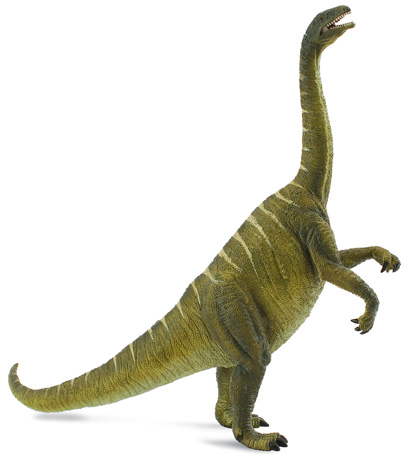The prosauropods were popularised by the German palaeontologist Friederich von Huene in response to his work studying the extensive Plateosaurus fossil finds discovered in a clay quarry at Trossingen (Baden-Württemberg, Germany). Much of our understanding of the Prosauropoda has been informed through study of Plateosaurus fossil material.
Once thought to be facultative bipeds. These dinosaurs would normally walk on all fours, but if they so desired they could adopt a bipedal stance. Detailed analysis of the manus and forelimbs demonstrated that the hands could not be rotated to set the palms on the ground. The lack of an ability to pronate the hand suggests that Plateosaurus and its close relatives were bipeds.
The picture (above) shows the now retired Bullyland Plateosaurus model. Plateosaurus is depicted as a quadruped, however, studies have shown that since this dinosaur could not pronate its wrists (turn the hand so that the palm could be placed on the ground), it probably was bipedal. Ironically, Bullyland’s original Plateosaurus figure was depicted rearing up onto its hind legs. The quadruped Bullyland Plateosaurus model was probably inspired by a Plateosaurus diorama at the Naturkundemuseum Stuttgart, Germany. The Plateosaurus models in the diorama are portrayed as quadrupeds. Bullyland’s range of prehistoric animal figures has been developed in partnership with the Naturkundemuseum Stuttgart.
The picture (above) shows the CollectA Age of Dinosaurs Plateosaurus replica. This model was first introduced into the not-to-scale CollectA Prehistoric Life model range in 2011. It is widely thought to be a more accurate representation of the Plateosaurus genus than the Bullyland figure.
To view the CollectA Prehistoric Live model range: CollectA Prehistoric Life and Age of Dinosaurs Models.
Plateosaurus and the Prosauropods
Huene, based on his studies of the Trossingen fossils, proposed that the Plateosaurus taxon was closely related to the Sauropoda. He erected the Sauropodomorpha clade. He proposed that this clade consisted of all the sauropods and their closest ancestors. Huene suggested the Prosauropoda, which means “before the sauropods”, be established which would include Plateosaurus and its close relatives.

A specimen of a Plateosaurus with fossil material mounted in life position. This is part of a display at the Senckenberg Nature Museum (Frankfurt, Germany). Picture credit: Everything Dinosaur.
Picture credit: Everything Dinosaur
Prosauropod Term Replaced by Non-sauropod Sauropodomorph
Gigantism in the Sauropodomorpha has been associated with the development of a fully quadrupedal stance. The grasping hands were lost as body size increased. Sauropods evolved column-like eggs to help support their increased bodyweight. This was thought to have occurred in the Early Jurassic. However, the discovery of massive Triassic sauropodomorphs such as Lessemsaurus and Ingentia prima demonstrates that sauropodomorph gigantism predates the Triassic-Jurassic boundary. The transition from being probable omnivores to a fully herbivorous diet occurred during the Late Triassic in some sauropodomorph lineages.
Basal sauropodomorphs are, generally, considered smaller-bodied and defined by their obligatory bipedalism. Facultative to habitual quadrupedality appears to have evolved by the Late Triassic. The paucity of the fossil record inhibits our understanding of the ancestry of the Sauropodomorpha.
Prosauropod as a scientific term has fallen out of favour. Definitions of prosauropods as having five digits on the manus with three claws and the concept of facultative bipedalism have largely become redundant. The idea that prosauropods are the direct ancestor of the sauropods has been discounted by many palaeontologists. Most modern phylogenetic studies break the Prosauropoda up into several families with shared anatomical traits that evolved separately and may represent a gradual transition to the generally larger, fully quadrupedal and herbivorous sauropodomorphs. Instead, the term non-sauropod sauropodomorph has taken precedence.
Cladistic and phylogenetic analysis have demonstrated that the taxa within the Prosauropoda corresponds to the Plateosauridae family as both contain the same genera.
The award-winning Everything Dinosaur website: Dinosaur Toys and Models.








Leave A Comment